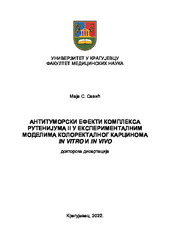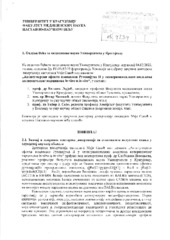Приказ основних података о дисертацији
Антитуморски ефекти комплекса Рутенијума II у експерименталним моделима колоректалног карцинома in vitro и in vivo
Antitumor effects of Ruthenium II complexes in experimental models of colorectal cancer in vitro and in vivo
| dc.contributor.advisor | Novokmet, Slobodan | |
| dc.contributor.other | Stojković, Miodrag | |
| dc.contributor.other | Sabo, Tibor | |
| dc.contributor.other | Milovanović, Marija | |
| dc.creator | Savić, Maja | |
| dc.date.accessioned | 2022-10-17T17:26:08Z | |
| dc.date.available | 2022-10-17T17:26:08Z | |
| dc.date.issued | 2022-07-21 | |
| dc.identifier.uri | http://eteze.kg.ac.rs/application/showtheses?thesesId=8560 | |
| dc.identifier.uri | https://fedorakg.kg.ac.rs/fedora/get/o:1515/bdef:Content/download | |
| dc.identifier.uri | https://nardus.mpn.gov.rs/handle/123456789/20749 | |
| dc.description.abstract | Uvod: Kompleksi platine, cisplatina i njeni analozi - karboplatina i oksaliplatina svrstavaju se u najčešće korišćene antitumorske metalofarmaceutike. Pored kliničkog uspeha koji poseduju, navedeni lekovi imaju i određena ograničenja, a to su sistemska toksičnost (nefrotoksičnost, hepatotoksičnost, neurotoksičnost, mijelotoksičnost i gastrointestinalna toksičnost) i učestalost rezistencije na njihovu primenu. Ova ograničenja su pokrenula istraživanja za drugim kompleksima prelaznih metala slične antitumorske aktivnosti ali prihvatljivijeg profila toksičnosti. Kompleksi rutenijuma privukli su veliko interesovanje kao potencijalni antitumorski agensi i to su jedini neplatinski kompleksi koji su ušli u fazu kliničkog testiranja kao hemioterapeutici. Cilj: Cilj ovog istraživanja je bio da ispita citotoksične efekte rutenijum(II) terpiridin kompleksa, [Ru(Cl-tpy)(en)Cl][Cl] (Ru-1) i [Ru(Cl-tpy)(dach)Cl][Cl] (Ru-2) prema humanim i mišjim ćelijskim linijama karcinoma kolona i mišjim mezenhimalnim matičnim ćelijama pomoću in vitro metoda. Pored toga, cilj je bio da se ispita antitumorska aktivnost in vivo i sistemska toksičnost rutenijum(II) terpiridinskih kompleksa u heterotopskom modelu karcinoma kolona i da se uporedi sa oksaliplatinom, koja je najčešće korišćeni metalofarmaceutik u lečenju karcinoma kolona. Materijal i metode: Ćelijske linije na kojima su ispitivani citotoksični efekti kompleksa rutenijuma(II) pomoću MTT testa su: ćelije karcinoma kolona izolovane iz BALB/c miševa - CT26, ćelijska linija humanog kolorektalnog adenokarcinoma (Dukes B) - SW480, ćelijska linija humanog epitelnog kolorektalnog karcinoma - HCT116 i mezenhimalne matične ćelije miša izolovane iz kostne srži C57Bl/6 miševa. Iste ćelijske linije su korišćene za ispitivanje uticaja rutenijum(II) terpiridinskih kompleksa na distribuciju ćelijskog ciklusa i tip ćelijske smrti, korišćenjem LDH testa i protočne citofluorimetrije nakon bojenja ćelija odgovarajućim fluorohromima. U in vivo eksperimentima su korišćeni miševi BALB/c soja, muškog pola, starosti 6-8 nedelja, mase od 20-25 grama. Model heterotopskog karcinoma kolona indukovan je subkutanom injekcijom 1×106 singenih CT26 ćelija suspendovanih u 100 μl DMEM medijuma u dorzolumbalnu regiju miša. Svaki kompleks je pojedinačno rastvoren u 200 μl fiziološkog rastvora i primenjen u dozi od 2 i 5 mg/kg. Intraperitonealna aplikacija ispitivanih kompleksa sprovedena je po šemi: 6., 9., 12. i 15. dana od inokulacije CT26 tumorskih ćelija. Miševi su svrstani u grupe u zavisnosti od toga čime su tretirani: kontrola (fiziološki rastvor), Ru-1, Ru-2 i oksaliplatina. Masa miševa je merena svaki treći dan, neposredno pre aplikacije ispitivanih kompleksa, kako bi doziranje bilo što preciznije. Eksperiment je trajao ukupno 18 dana, a miševi su žrtvovani 13. dan od prve aplikovane doze i tom prilikom je sakupljena krv i izolovani su unutrašnji organi kao i primarna tumorska masa za dalje analize. Radi procene sistemske toksičnosti primenjenih kompleksa sprovedene su biohemijske analize uree, kreatinina, kao i enzima jetre AST i ALT iz krvi, a izolovani organi su patohistološki analizirani. Iz tkiva izolovanih organa određivani su: marker oksidacionog stresa - indeks lipidne peroksidacije, enzimi antioksidacione zaštite (superoksid-dismutaza i katalaza) i neenzimski antioksidans – redukovani glutation. Rezultati: Kompleksi rutenijuma(II) ispoljili su umerenu do jaku citotoksičnost prema humanim (HCT116 i SW480) i mišjoj (CT26) ćelijskoj liniji karcinoma kolona i mišjim mezenhimalnim matičnim ćelijama, sa vrednostima IC50 u rasponu od 19,1 do 167,3 μM. Rutenijum(II) terpiridinski kompleksi su kod humanih i mišjih ćelija karcinoma kolona indukovali apoptozu u niskom procentu, dok je taj procenat bio znatno viši kod mišjih mezenhimalnih matičnih ćelija. Sa druge strane, kompleksi rutenijuma(II) su indukovali u značajnom procentu nekrozu ćelija karcinoma kolona i mišjih mezenhimalnih matičnih ćelija. Takođe, oba kompleksa su specifično za ćelijsku liniju indukovali poremećaje ćelijskog ciklusa, odnosno indukovali su zastoj najčešće u G2/M fazi ćelijskog ciklusa. Kompleks [Ru(Cl-tpy)(en)Cl][Cl] je značajno inhibirao rast primarnog heterotopskog tumora kod miševa, podjednako ili čak bolje od oksaliplatine, u zavisnosti od primenjene doze. Oba ispitivana rutenijum(II) terpiridin kompleksa su dovela do ozbiljnijeg oštećenja jetre, bubrega i srca, u poređenju sa oksaliplatinom, što je procenjeno na osnovu biohemijskih analiza (uree, kreatinina, AST i ALT) i histopatološke analize organa. S obzirom na zabeležene povišene vrednosti TBARS u tkivu srca i bubrega kod miševa tretiranih kompleksima rutenijuma(II), pretpostavlja se da indukcija oksidativnog stresa usled njihove primene može imati ulogu u ispoljavanju sistemske toksičnosti. Zaključak: Analizom rezultata našeg istraživanja, dolazimo do zaključka da rutenijum(II) terpiridinski kompleks - [Ru(Cl-tpy)(en)Cl][Cl] ispoljava značajnu citotoksičnu aktivnost prema humanim i mišjim ćelijskim linijama karcinoma kolona, ali i mišjim mezenhimalnim matičnim ćelijama, kao i da poseduje in vivo antitumorsku aktivnost kod miševa kojima je indukovan CT26 karcinom kolona, slično oksaliplatini, ali uz izraženiju hepatotoksičnost, nefrotoksičnost i kardiotoksičnost u poređenju sa oksaliplatinom. | sr |
| dc.description.abstract | Introduction: Platinum complexes, cisplatin and its analogues - carboplatin and oxaliplatin are among the most commonly used antitumor metallopharmaceuticals. Beside their clinical success, there has been some limitatios observed: systemic toxicity (nephrotoxicity, hepatotoxicity, neurotoxicity, myelotoxicity and gastrointestinal toxicity) and the incidence of innate or acquired drug resistance. These limitations have initiated new investigations for other transition metal complexes that will show similar antitumor activity but being less toxic. Ruthenium complexes have attracted considerable interest as potential antitumor agents and these are the only non-platinum complexes that have entered the clinical testing phase as chemotherapeutics. Objective: The aim of this study was to examine cytotoxic effects of ruthenium(II) terpyridine complexes, [Ru(Cl-tpy)(en)Cl][Cl] (Ru-1) and [Ru(Cl-tpy)(dach)Cl][Cl] (Ru-2) towards human and murine colon carcinoma cell lines and mouse mesenchymal stem cells, by in vitro methods. In addition, the goal was to be examined antitumor activity in vivo and systemic toxicity of ruthenium(II) terpyridine complexes in mouse heterotopic model of colorectal carcinoma and compared with oxaliplatin, the most usually used metallopharmaceuticals against colorectal carcinoma. Materials and Methods: The cell lines on which the cytotoxic effects of the ruthenium(II) complex were examined using the MTT test are: colon carcinoma cells isolated from BALB/c mice - CT26, human colorectal adenocarcinoma cell line (Dukes B) - SW480, human epithelial colon carcinoma cell line - HCT116 and mouse mesenchymal stem cells isolated from bone marrow of C57Bl/6 mice. The same cell lines were used to examine the effects of ruthenium(II) terpyridine complexes on cell cycle distribution and cell death type, using the LDH assay and flow cytofluorimetry after staining the cells with the appropriate fluorochromes. Тhe male BALB/c mice, age of 6–8 weeks, with weight around 20–25 g were used in in vivo experiment. A model of heterotopic colon cancer was induced by subcutaneous injection of 1 × 106 syngeneic CT26 cells suspended in 100 μl of DMEM into the dorsolumbar region of the mouse. Each complex was individually dissolved in 200 μl of saline and administered at a dose of 2 and 5 mg/kg. Intraperitoneal application of the examined complexes was performed according to the scheme: 6, 9, 12 and 15 days after inoculation of CT26 tumor cells. The mice were divided into groups depending on which were treated with: control (saline), Ru-1, Ru-2 and oxaliplatin. The weight of the mice was measured every third day, immediately before the application of the tested complexes, in order to make the dosing as accurate as possible. The experiment lasted 18 days in total, mice were sacrificed on day 13 of the first administered dose and on that occasion blood was collected and internal organs as well as the primary tumor mass were isolated for further analysis. In order to assess the systemic toxicity of the applied complexes, biochemical analyzes of urea, creatinine, as well as liver enzymes AST and ALT from the blood were determined, and isolated organs were pathohistologically analyzed. From the tissues of isolated organs, the following were determined: oxidative stress marker - lipid peroxidation index, antioxidant protection enzymes (superoxide dismutase and catalase) and non - enzymatic antioxidant - reduced glutathione. Results: Ruthenium(II) complexes showed moderate to strong cytotoxicity toward human (HCT116 and SW480) and mouse (CT26) colon carcinoma cell lines and mouse mesenchymal stem cells with IC50 values ranged between 19,1 to 167,3 μM. Ruthenium (II) terpyridine complexes induced apoptosis in human and mouse colon cancer cells in a low percentage, while this percentage was significantly higher in mouse mesenchymal stem cells. On the other hand, ruthenium(II) complexes induced necrosis of colon cancer cells and mouse mesenchymal stem cells. Also, both complexes induced cell cycle disturbances, but these effects were specific for the cell line, respectively, induced arrest of cell cycle most often in the G2/M phase. The [Ru(Cl-tpy)(en)Cl][Cl] complexes significantly inhibited growth of primary heterotopic tumor in mice, equally or even better to oxaliplatin, depending on the dose administered. Both examined ruthenium(II) terpyridine complexes led to more serious liver, kidney and heart damage, compared to oxaliplatin, which was assessed on the basis of biochemical analysis (urea, creatinine, AST and ALT) and histopathological analysis of organs. Given the observed elevated values of TBARS in cardiac and renal tissue in mice treated with ruthenium (II) complexes, it is assumed that the induction of oxidative stress due to their application may play a role in the use of systemic toxicities. Conclusion: Our data highlight the significant cytotoxic activity of [Ru(Cl-tpy)(en)Cl][Cl] against human and mouse colon carcinoma cells as well as in vivo antitumor activity in CT26 tumor bearing mice similar to chemioterapeutic oxaliplatin, but with more pronounced hepatotoxicity, nephrotoxicity and cardiotoxicity in comparison with oxaliplatin. | en |
| dc.format | application/pdf | |
| dc.language | sr | |
| dc.publisher | Универзитет у Крагујевцу, Факултет медицинских наука | sr |
| dc.rights | openAccess | en |
| dc.rights.uri | https://creativecommons.org/licenses/by-nc-nd/4.0/ | |
| dc.source | Универзитет у Крагујевцу | sr |
| dc.subject | rutenijum(II) kompleksi | sr |
| dc.subject | ruthenium(II) complexes | en |
| dc.subject | cytotoxicity | en |
| dc.subject | oxaliplatin | en |
| dc.subject | colon carcinoma | en |
| dc.subject | mesenchymal stem cells | en |
| dc.subject | citotoksičnost | sr |
| dc.subject | oksaliplatina | sr |
| dc.subject | karcinom kolona | sr |
| dc.subject | mezenhimalne matične ćelije | sr |
| dc.title | Антитуморски ефекти комплекса Рутенијума II у експерименталним моделима колоректалног карцинома in vitro и in vivo | sr |
| dc.title.alternative | Antitumor effects of Ruthenium II complexes in experimental models of colorectal cancer in vitro and in vivo | en |
| dc.type | doctoralThesis | |
| dc.rights.license | BY-NC-ND | |
| dc.identifier.fulltext | http://nardus.mpn.gov.rs/bitstream/id/146434/Izvestaj_Maja_Savic_Medicina.pdf | |
| dc.identifier.fulltext | http://nardus.mpn.gov.rs/bitstream/id/146433/Doctoral_thesis_12625.pdf | |
| dc.identifier.rcub | https://hdl.handle.net/21.15107/rcub_nardus_20749 |



